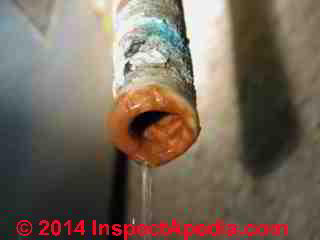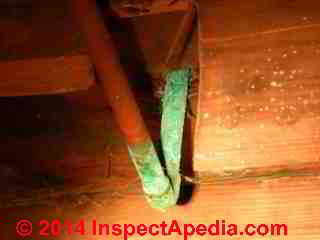 Acidic Corrosive Water
Acidic Corrosive Water
Detection, effects, cures for low pH aggressive water. Langlier Index
- POST a QUESTION or COMMENT about this article topic.
Aggressive, corrosive, low pH water - acidic water:
This article describes effects of low pH, acidic or corrosive water on building piping, leaks, dissolved copper, health hazards, and the plumbing system in general. We describe how to detect corrosive or aggressive water and what should be done about it.
The Langlier index is defined and its use in evaluating the corrosivity of a water supply is explained. This article also describes other factors in the formation of leaks in building water piping including scouring, debris, & the effects of hot water on water pH. The article links to more information about green stains traced to the water supply.
InspectAPedia tolerates no conflicts of interest. We have no relationship with advertisers, products, or services discussed at this website.
- Daniel Friedman, Publisher/Editor/Author - See WHO ARE WE?
Acidic water & copper pipe corrosion/leak risk / leak prevention
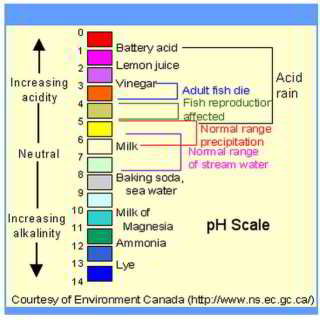 Corrosive water is responsible for health effects of increased lead, copper or other contaminants in drinking water and corrosive water in building plumbing & heating systems is also responsible for costly leak damage.
Corrosive water is responsible for health effects of increased lead, copper or other contaminants in drinking water and corrosive water in building plumbing & heating systems is also responsible for costly leak damage.
Article Series Contents
- CORROSIVITY or ACIDITY of WATER
- CORROSIVITY PROBLEMS in WATER SYSTEMS
- CAUSES of CORROSIVE WATER
- COPPER IN WATER, HEALTH EFFECTS
- pH of DRINKING WATER, HEALTH EFFECTS
- LANGLIER SATURATION INDEX LSI
- LEAD IN DRINKING WATER, HOW to REDUCE
- LEAK INSPECTION of WATER SYSTEMS
- OTHER CAUSES of PINHOLE LEAKS in COPPER PIPES
- OTHER CAUSES of PIPE PITTING: pH & HCO3 LEVELS
- PINHOLE LEAKS by ELECTRICAL GROUND ERRORS
Problems caused by aggressive / corrosive water
- Corrosive water invites plumbing leaks or leaks in hot water or steam heating systems, water heaters, pipes, water tanks, other metal components in the water handling system that that can lead to very costly damage to the building or its mechanical systems.
Corrosion causes both pinhole leaks and stress cracking in metal components. (Jones 1998, Was 2007). - Corrosive water dissolves lead or copper into drinking water, leading to potentially serious health risks. (Isaac 1997 et als)
See LEAD IN DRINKING WATER, HOW to REDUCE for an example of lead contamination in the Flint Michigan water supply.
At "COPPER PIPE PINHOLE LEAKS: cause, cure, prevention" we point out that water chemistry itself can be a source of metal water pipe (and even drain pipe) corrosion.
From our illustration adapted from Environment-Canada you can see a pH scale showing that
- high pH numbers are more alkaline (more basic) while
- low pH numbers mean that a substance (water in our case) is acidic.
[Click to enlarge any image]
Neutral pH values are in the middle of the range. Low pH or acidic water is corrosive or is referred to as aggressive water.
Before we explain the details of the causes and effects of aggressive or corrosive water, here is an except from our copper pipe leak discussion:
If the pH is low <6.0, the hardness low generally<50ppm, the alkalinity low generally <40ppm, the water could be considered extremely “soft” and aggressive to the home’s metallic plumbing system.
If the chlorides are elevated >100ppm this would only compound the problem. The water should be treated to make the water less aggressive by raising the pH, alkalinity or hardness. - CT DOH.[1]
Top Ten Factors Affecting the Corrosivity of Water
- Bacteria level in water (bacteria such as sulphur reducing bacteria (SRB) increase the corrosivity level of water) (Little 2007)
- Chlorine level in water (higher chlorine levels in water make the water more corrosive)
- Conductivity of water (higher electrical conductivity means more corrosive; some dissolved salts or metals increase conductivity)
- Gases dissolved in water (higher levels of certain gases including oxygen or carbon dioxide (CO2) increase water corrosivity) (De Waard 1975)
- Mass ratio (CMSR) of chloride to sulfate: a CMSR more than 0.2 but less than 0.5 increases the risk of corrosion; and a CMSR greater than 0.5 when combined with an alkalinity less than 50mg of calcium carbonates (CaCO3) per liter is likely to be corrosive
- Solids dissolved in water (higher dissolved solids such as salts and sulfates increase water corrosivity both chemically and by encouraging bio-chemical corrosion)
- Solids suspended in water (more suspended solids such as sand or sediment and even moving rust particles increase corrosion by abrasion)
- Water flow rate through building piping (faster flow rates increase corrosive effects)
- Water temperature (higher temperatures mean more corrosive water)
- Water pH that is below 6.5 or above 8.5. Low pH (acidic) water is corrosive while high pH (alkaline) water forms scale that can actually protect against corrosion.
Adapted from Sigler & Bauder ret. 2017, Kiene 1998, Oram, Water Research Center ret. 2017 cited at REFERENCES
Other Water Conditions Causing Pitting & Leaks in Copper Piping: pH & HCO3 Levels
Mattsson et als (1968) provide a helpful elaboration of the causes of failures in copper piping due to pitting and corrosion from which we quote these excerpts:
An investigation of failures of hard-drawn copper water pipes (phosphorus-deoxidised copper) in service due to pitting corrosion was conducted from November, 1962 to February, 1965.
Fifteen cases were reported. All those about which information could be obtained came from hot water installations and occurred in water with a low pH (?7) and a HCO3- content of, at the most, 100 mg/l but generally below 50 mg/1.
Failures not due to pitting corrosion (i.e. caused by erosion and corrosion or corrosion fatigue) occurred in waters with a higher pH and higher HCO3- content.
A laboratory investigation into the ability of the corrosion products to counteract further corrosion in different types of water was also carried out, using an electrolytic cell which, in principle, was a model of an active pit in a copper tube. This led to the following conclusions, which are in good agreement with the results obtained from the examination of service failures:
If the pH value of the water is high enough, the copper dissolved by the corrosion can be precipitated as basic copper salt. At low pH values such precipitation does not take place.
If the [HCO3?]/[SO42?] ratio in the water is high, dissolved copper can be precipitated as basic copper carbonate in the neighbourhood of the corrosion site and counteract further corrosion.
At a low [HCO3?]/[SO42?] ratio, crusts of basic copper sulphate will be precipitated at some distance from the corrosion site and may lead to a high corrosion rate.
Pitting is not likely to occur in hot water tubes of hard copper if the pH is ? 7·4 and the [HCO3?]/[SO42?] ratio ?1 (the concentrations given in mg/1). The critical values mentioned are approximate and may be adjusted in the light of future experience. - [14] "Pitting Corrosion in Copper Tubes – Cause of Corrosion and Counter-Measures", Mattsson, E.; Fredriksson, A.-M., British Corrosion Journal, Volume 3, Number 5, September 1968
For our readers who skipped high-school chemistry:
- HCO3 is an chemical abbreviation for bicarbonate, an anion of carbonic acid from which one hydrogen atom (H) has been removed. Synonyms include hydrogen carbonate or hydrogencarbonate. You can see from the formula that an HCO3 molecule contains one Hydrogen atom, one Carbon atom and three Oxygen atoms.
- SO42 in the quote from Mattson might be written more commonly as SO4-2, is a sulfate ion, more often y seen as HSO4-2 hydrogen sulfate, or in water systems more likely as Ca(HSO4)2 Calcium hydrogen sulfate or as Magnesium Hydrogen Sulfate Mg(HSO4)2
Continue Reading at PINHOLE LEAKS by ELECTRICAL GROUND ERRORS
More about Acidic Water & Acid Neutralizers on Building Water Supplies
The following articles on acidic water and its corrosive effects are by Steve Bliss, editor of our sister website BuildingAdvisor.com
- ACID NEUTRALIZERS (in WHOLE HOUSE WATER TREATMENT) - retrieved 2018/01/14, original source https://buildingadvisor.com/buying-land/water-wells/whole-house-water-treatment/#jump3
Excerpts:
Two types of equipment are used in homes to neutralize acidic water that is causing problems, such as blue stains of fixtures and corrosion. The most common system is a neutralizing filter. In the other a chemical feed pump or metering pump is used to inject neutralizing chemicals.
A neutralizing filter runs the water though a tank filled with calcium carbonate or ground limestone, and sometimes magnesium oxide or other minerals for high acidity.
In a chemical feeder, a small pump is used to inject a solution of soda ash (similar to baking soda) and water directly into the well or into the plumbing before it enters the pressure tank. First a small amount of soda ash is mixed with water in a holding tank, and the injection pump is activated with the well pump kicks on. - HARD WATER, ACIDITY AND TURBIDITY - retrieved 2018/01/14, original source https://buildingadvisor.com/buying-land/water-wells/water-quality/#jump6
Excerpts:
Acidic water, metallic leaching, and lead poisoning. Like water hardness, acidity is a natural condition of some well water that is a nuisance but generally not a health hazard. Water with a pH below 7.0 is considered acidic; above 7.0 it is basic or alkaline. The U.S. EPA doesn’t regulate the pH level in drinking water, but it recommends levels from 6.5 to 8.5.
Alkalinity is not a health problem, but highly alkaline water can make drinks such as coffee taste bitter, cause scale to build up in plumbing; and reduce the efficiency of electric water heaters.
Highly acidic water will leach copper or iron from the inside of piping and deposit blue-green (copper) or rust-colored (iron) scale on sinks, tubs, and other plumbing fixtures. The corrosive effect can also affect metal finishes and lead to pinhole leaks in plumbing over many years as well as a bitter metallic taste.
More ominously, acidic water can leach lead from lead pipes, plumbing fixtures, and solder in copper plumbing. - TREATMENTS for ACIDIC WATER - retrieved 2018/01/14, original source https://buildingadvisor.com/treatments-for-acidic-water/
Excerpts:
If acidic water is a problem, the simplest approach is to install a whole-house acid neutralizer, which adds a little calcium carbonate to the water. I’ve had a system in a home for a couple of years. In addition to eliminating the blue stains, the water tastes a lot better, due to less dissolved metals in the water.
To reduce acidity, water is piped from the pressure tank to the tall fiberglass tank filled with calcium carbonate (see photo). The multiple shut-offs into and out of the tank, allow for easy flushing of the tank with water flow in either direction.
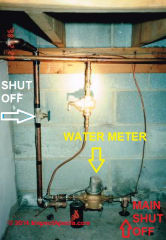 More Causes of Pinhole Leaks in Copper Pipes in Buildings
More Causes of Pinhole Leaks in Copper Pipes in Buildings
Besides corrosive water there are other common and some un-common causes of pinholes or other perforation leaks in copper pipes in building supply and drain piping are listed at OTHER CAUSES of PINHOLE LEAKS in COPPER PIPES
Health impacts of copper on drinking water
Moved: see COPPER IN WATER, HEALTH EFFECTS
Limits for Copper in Drinking Water
Moved: see COPPER LIMITS in DRINKING WATER
Corrosivity & Lead in Drinking Water
See LEAD IN DRINKING WATER, HOW to REDUCE for a discussion of lead contamination in drinking water such as in Flint Michigan in the U.S. - a problem stemming from a combination of corrosive water and lead water supply piping.
Also see LEAD in WATER, ACTION GUIDE.
WHO Advice on Water pH - health effects
See pH of DRINKING WATER, HEALTH EFFECTS
Optimum pH for a Building Water Supply
See pH TARGET for DRINKING WATER, WHO
Acidic Water Treatments to Raise the pH
See pH TOO LOW, ACIDIC WATER ADVICEAcidic Well Water
Please see pH INCREASE to REDUCE ACIDITYWater Corrosivity Measurement: Langelier Saturation Index
Definition of the Langlier Index (LI) has moved to LANGLIER SATURATION INDEX LSI
Also see SCALE PREVENTION, WATER HEATER
Water Corrosivity Action Levels in the Langelier (LSI) Index
This topic has moved to LANGLIER INDEX ACTION LEVELS
Also see in that article LANGLIER INDEX ACTION LEVELS.
Inspect copper piping for leaks, corrosion, pinholes & leak risk factors
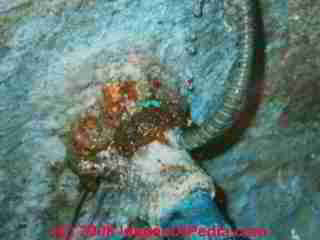 This discussion is now expanded and found at LEAK INSPECTION of WATER SYSTEMS
This discussion is now expanded and found at LEAK INSPECTION of WATER SYSTEMS
Electrical Ground Wiring Errors Can Cause Plumbing Pipe Leaks
Now in a separate article PINHOLE LEAKS by ELECTRICAL GROUND ERRORS we add an electrical ground defect that can cause leaks in metal pipes carrying water, sewage, even air conditioning or heat pump refrigerant.
Effects of hot water on water pH
Please see WATER TEMPERATURE EFFECT on pH
That about exhausts me [DF] on copper pipes, pH, corrosion, copper testing, Langelier index, and treatment for low pH water. Thanks for asking.
...
Continue reading at COPPER IN WATER, HEALTH EFFECTS or select a topic from the closely-related articles below, or see the complete ARTICLE INDEX.
Or see these
Recommended Articles
- WATER TREATMENT EQUIPMENT CHOICES - topic home,
- LEAK CAUSES in WATER PIPING
- LEAK TYPES, WATER SUPPLY or DRAIN PIPES - where do leaks occur and how to find them
- PLUMBING LEAK DETECTION METHODS
- PLUMBING LEAK DETECTION & SHUTOFF DEVICES
- WATER HARDNESS: HOW TO MEASURE
- WATER STAINING CONTAMINANTS
Suggested citation for this web page
CORROSIVITY or ACIDITY of WATER at InspectApedia.com - online encyclopedia of building & environmental inspection, testing, diagnosis, repair, & problem prevention advice.
Or see this
INDEX to RELATED ARTICLES: ARTICLE INDEX to WATER TREATMENT SYSTEMS
Or use the SEARCH BOX found below to Ask a Question or Search InspectApedia
Ask a Question or Search InspectApedia
Try the search box just below, or if you prefer, post a question or comment in the Comments box below and we will respond promptly.
Search the InspectApedia website
Note: appearance of your Comment below may be delayed: if your comment contains an image, photograph, web link, or text that looks to the software as if it might be a web link, your posting will appear after it has been approved by a moderator. Apologies for the delay.
Only one image can be added per comment but you can post as many comments, and therefore images, as you like.
You will not receive a notification when a response to your question has been posted.
Please bookmark this page to make it easy for you to check back for our response.
IF above you see "Comment Form is loading comments..." then COMMENT BOX - countable.ca / bawkbox.com IS NOT WORKING.
In any case you are welcome to send an email directly to us at InspectApedia.com at editor@inspectApedia.com
We'll reply to you directly. Please help us help you by noting, in your email, the URL of the InspectApedia page where you wanted to comment.
Citations & References
In addition to any citations in the article above, a full list is available on request.
- De Waard, C., and D. E. Milliams. "Carbonic acid corrosion of steel." Corrosion 31, no. 5 (1975): 177-181.
- Isaac, R. A., L. Gil, A. N. Cooperman, K. Hulme, B. Eddy, M. Ruiz, K. Jacobson, C. Larson, and O. C. Pancorbo. "Corrosion in drinking water distribution systems: a major contributor of copper and lead to wastewaters and effluents." Environmental science & technology 31, no. 11 (1997): 3198-3203.
- Jones, Anne. "Stress corrosion cracking." In in ASM Handbook, Metals Handbook. 1998.
- Kermani, M. B., and A. Morshed. "Carbon dioxide corrosion in oil and gas production—a compendium." Corrosion 59, no. 8 (2003): 659-683.
- Kiene, L., W. Lu, and Y. Levi. "Relative importance of the phenomena responsible for chlorine decay in drinking water distribution systems." Water Science and Technology 38, no. 6 (1998): 219-227.
- Kritzer, Peter. "Corrosion in high-temperature and supercritical water and aqueous solutions: a review." The Journal of Supercritical Fluids 29, no. 1 (2004): 1-29.
- Little, Brenda J., Florian B. Mansfeld, Peggy J. Arps, and James C. Earthman. Microbiologically influenced corrosion. Wiley‐VCH Verlag GmbH & Co. KGaA, 2007.
- Oram, Brian, "Drinking Water Issues Corrosive Water (Lead, Copper, Aluminum, Zinc, and More)" (web page), Water Research Center, Water Research Center B.F. Environmental Consultants Inc. 15 Hillcrest Drive, Dallas, PA 18612, USA, retrieved 2017/02/16, original source: http://www.water-research.net/index.php/drinking-water-issues-corrosive-water-lead-copper-aluminum-zinc-and-more
- Roberge, P. R. (1999). Handbook of Corrosion Engineering (1st ed.). McGraw-Hill Professional. ISBN 0-07-076516-2.
- Sigler, W. Adam, and Bauder, Jim, "CORROSIVITY" [PDF], Montana State University Extension, Water Quality Program, Department of Land Resources and Environmental Sciences, (un-dated) retrieved 2017/02/16, original source: http://waterquality.montana.edu/well-ed/files-images/Corrosivity.pdf - note that this page was adapted from Wilkes University Center For Environmental Quality; Corrosion, Saturation Index, Balanced Water in Drinking Water Systems
- Speller, Corrosion. Causes and Prevention of Corrosion in Steam and Hot Water Heating Systems. McGraw-Hill, 1951.
- Volk, Christian, Esther Dundore, John Schiermann, and Mark LeChevallier. "Practical evaluation of iron corrosion control in a drinking water distribution system." Water research 34, no. 6 (2000): 1967-1974.
- Was, G. S., P. Ampornrat, G. Gupta, S. Teysseyre, E. A. West, T. R. Allen, K. Sridharan et al. "Corrosion and stress corrosion cracking in supercritical water." Journal of Nuclear Materials 371, no. 1 (2007): 176-201.
- [2] Clean Water Systems & Stores, Inc. 2806-A Soquel Ave, Santa Cruz, California 95062, Telephone: 1-888-600-5426 or international: 1-831-462-8500 . web search 4/23/12, original source: - cleanwaterstore.com/copper-pipe-corrosion.html
- [3] "pH in Drinking-water Background document for development of WHO Guidelines for Drinking-water Quality", in Guidelines for drinking-water quality, 2nd ed. Vol. 2. Health criteria and other supporting information, World Health Organization, Geneva, 1996. Web search 4/23/12, original source: http://www.who.int/water_sanitation_health/dwq/chemicals/en/ph.pdf
- [4] "Langelier Saturation Index (LSI), Wikipedia Web: https://www.wikipedia.org/ provided background information about some topics discussed at this website provided this citation is also found in the same article along with a " retrieved on" date. NOTE: because Wikipedia entries are fluid and can be amended in real time, we cite the retrieval date of Wikipedia citations and we do not assert that the information found there is necessarily authoritative.
- [5] "Drinking Water Contaminants, List of Contaminants & their MCLs", U.S. EPA United States Environmental Protection Agency, National Primary Drinking Water Regulations, web search 4/23/12, original source: http://water.epa.gov/drink/contaminants/index.cfm#List
- [6] "Basic Information about Copper in Drinking Water", U.S. EPA United States Environmental Protection Agency, web search 4/23/12, original source: http://water.epa.gov/drink/contaminants/basicinformation/copper.cfm
- [7] "Fin Tube / Bare Elements", Slant/Fin Boilers & Baseboards, Slant/Fin Corporation, 100 Forest Drive, Greenvale, NY 11548, Phone: (516) 484-2600, Fax: (516) 484-5921, E-mail: info@slantfin.com, web search 4/23/12, original source: http://www.slantfin.com/index.php/products/baseboard-residential/fin-tube--bare-elements
- ABS Plastic Drain/Waste/Vent (DWV) pipe failures: reported for Centaur, Phoenix, Polaris, Gable, and Spartan pipe mfgs. for pipe made between 1985 and 1988. CPSC Hot Line: 800-638-8270 or ABS Drain Leaks/Failures-Class Action Settlement COX settlement through Shell Oil set up by a contractor involved in the settlement. Polybutylene Plumbing Failures: Spencer Class settlement, Web: spencerclass.com, 10% of replacement cost/damages, only for acetal (plastic)fittings Polybutylene piping lawsuit settlement website Polybutylene plumbing lawsuit proposed settlement-old site
- [11] plumbing911.com/poly/ Polybutylene Plumbing Failures , Lots of Info about, but slow-loading busy site - appears dead 2024/01/24
- [12] Compression fittings for plumbing connections, Wikipedia photograph, web search 08/09/2010, original source: http://en.wikipedia.org/wiki/File:Robinetterie-raccords.JPG
- [13] "Guidelines for drinking-water quality", 2nd ed. Vol. 2. Health criteria and other supporting information. World Health Organization, Geneva, 1996. WHO, op.cit.
- [14] "Pitting Corrosion in Copper Tubes – Cause of Corrosion and Counter-Measures", Mattsson, E.; Fredriksson, A.-M., British Corrosion Journal, Volume 3, Number 5, September 1968 , pp. 246-257(12), Maney Publishing, Quoting the article abstract:
An investigation of failures of hard-drawn copper water pipes (phosphorus-deoxidised copper) in service due to pitting corrosion was conducted from November, 1962 to February, 1965. Fifteen cases were reported. All those about which information could be obtained came from hot water installations and occurred in water with a low pH (?7) and a HCO3- content of, at the most, 100 mg/l but generally below 50 mg/1. Failures not due to pitting corrosion (i.e. caused by erosion and corrosion or corrosion fatigue) occurred in waters with a higher pH and higher HCO3- content.
A laboratory investigation into the ability of the corrosion products to counteract further corrosion in different types of water was also carried out, using an electrolytic cell which, in principle, was a model of an active pit in a copper tube. This led to the following conclusions, which are in good agreement with the results obtained from the examination of service failures:
If the pH value of the water is high enough, the copper dissolved by the corrosion can be precipitated as basic copper salt. At low pH values such precipitation does not take place.
If the [HCO3?]/[SO42?] ratio in the water is high, dissolved copper can be precipitated as basic copper carbonate in the neighbourhood of the corrosion site and counteract further corrosion.
At a low [HCO3?]/[SO42?] ratio, crusts of basic copper sulphate will be precipitated at some distance from the corrosion site and may lead to a high corrosion rate.
Pitting is not likely to occur in hot water tubes of hard copper if the pH is ? 7·4 and the [HCO3?]/[SO42?] ratio ?1 (the concentrations given in mg/1). The critical values mentioned are approximate and may be adjusted in the light of future experience. - [15] "Health and aesthetic impacts of copper corrosion on drinking water",
Dietrich AM, Glindemann D, Pizarro F, Gidi V, Olivares M, Araya M, Camper A, Duncan S, Dwyer S, Whelton AJ, Younos T, Subramanian S, Burlingame GA, Khiari D, Edwards M., Virginia Tech, Blacksburg, VA 24061-0246, USA. andread@vt.edu, Water Sci Technol. 2004;49(2):55-62., Abstract
Traditional research has focused on the visible effects of corrosion--failures, leaks, and financial debits--and often overlooked the more hidden health and aesthetic aspects. Clearly, corrosion of copper pipe can lead to levels of copper in the drinking water that exceed health guidelines and cause bitter or metallic tasting water. Because water will continue to be conveyed to consumers worldwide through metal pipes, the water industry has to consider both the effects of water quality on corrosion and the effects of corrosion on water quality. Integrating four key factors--chemical/biological causes, economics, health and aesthetics--is critical for managing the distribution system to produce safe water that consumers will use with confidence. As technological developments improve copper pipes to minimize scaling and corrosion, it is essential to consider the health and aesthetic effects on an equal plane with chemical/biological causes and economics to produce water that is acceptable for public consumption.
Other water supply and drain piping and water pressure articles:
- Clogged Drain Diagnosis: Is it a blocked drain or the septic system? - A First Step for Homeowners
- CROSS CONNECTIONS, PLUMBING - bacterial contamination of building piping - sources
- Plastic Water Supply & Drain Piping Failures, Leaks, Repairs, Lawsuits: Water Supply Piping Defects and Plastic or polybutylene water supply piping failures, leaks, and litigation.
- PLASTIC PIPING ABS CPVC PB PEX PPR PVC - Leaks, Repairs, Lawsuits: Water Supply Piping Defects and Plastic or polybutylene water supply piping failures, leaks, and litigation. Our main article on plastic supply and drain piping leaks, failures, litigation, repairs, at PLASTIC PIPING ABS CPVC PB PEX PPR PVC. Excerpts are just below.
- PB (polybutylene with mechanical fittings) Piping leaks: especially in mobile homes and in the U.S. South, for example trailers and double-wides throughout Florida that were piped with this material - per M Cramer. See "Polybutylene Piping: Time Bomb?" Daniel Friedman, Journal of Light Construction, August 1996 [Technical Q&A] .
- Plastic Supply and Drain Piping Failures: leaks, lawsuits, settlements
- If plastic water piping is installed, such as polybutylene water supply piping, it should be at least 18" from the water heater.
- New mobile home and trailer units: 3/4" supply piping, min 6" off ground; shutoff valve required;
- TRANSITE PIPE WATER SUPPLY PIPING - what are the health hazards and other risks from cement asbestos (transite) water pipes?ir
- WATER PUMP PRESSURE SWITCH NUT ADJUSTMENTS how to adjust the water pressure in a building
- Water Pressure Loss - Diagnosis how to determine why water pressure has been lost or why there is no water at all in a building
- Water Testing for contaminants in drinking water - what test are available, what tests to ask for, what they cost, how people cheat on water tests
- Wells, Cisterns,& Springs types of sources of drinking water, what they look like, what goes wrong, what to do about itWATER PRESSURE LOSS how to diagnose the cause of bad water pressure
- WATER PRESSURE BOOSTING how to install a system to increase water pressure at a building
- WINTERIZE A BUILDING: how to freeze-proof plumbing in a building, how to avoid freezing pipes, how to thaw frozen pipes: how to winterize a building against freezing and frost damage.
- Our recommended books about building & mechanical systems design, inspection, problem diagnosis, and repair, and about indoor environment and IAQ testing, diagnosis, and cleanup are at the InspectAPedia Bookstore. Also see our Book Reviews - InspectAPedia.
- In addition to citations & references found in this article, see the research citations given at the end of the related articles found at our suggested
CONTINUE READING or RECOMMENDED ARTICLES.
- Carson, Dunlop & Associates Ltd., 120 Carlton Street Suite 407, Toronto ON M5A 4K2. Tel: (416) 964-9415 1-800-268-7070 Email: info@carsondunlop.com. Alan Carson is a past president of ASHI, the American Society of Home Inspectors.
Thanks to Alan Carson and Bob Dunlop, for permission for InspectAPedia to use text excerpts from The HOME REFERENCE BOOK - the Encyclopedia of Homes and to use illustrations from The ILLUSTRATED HOME .
Carson Dunlop Associates provides extensive home inspection education and report writing material. In gratitude we provide links to tsome Carson Dunlop Associates products and services.


